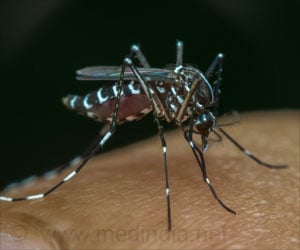
‘High-resolution structure of chikungunya virus could aid to screen experimental drugs for their ability to block binding to the joint protein, assess if the antibodies elicited by investigational vaccines are likely to prevent infection.’
Read More..Tweet it Now
"Chikungunya arthritis comes on very suddenly and can be very painful - people can barely walk around - and we have nothing specific to treat or prevent it," said co-senior author Michael S. Diamond, MD, PhD, the Herbert S. Gasser Professor of Medicine, and a professor of molecular microbiology, and of pathology and immunology.Read More..
"Now that we have these new structures, we can see how to disrupt the interaction between the virus and the protein it uses to get inside cells in the joints and other musculoskeletal tissues in order to block infections," added co-senior author Daved Fremont, PhD, a professor of pathology and immunology, of biochemistry and molecular biophysics, and of molecular microbiology.
Chikungunya and its cousins - Mayaro, Ross River and O'nyong-nyong viruses - belong to a family of alphaviruses that are spread by mosquitoes and cause joint pain. In recent years, such viruses have been infecting people and animals in ever larger regions of the globe.
In 2018, Diamond, Fremont and colleagues including postdoctoral researcher Rong Zhang, PhD, identified the protein Mxra8, which is found on the outer surface of cells in the joints, as the molecular handle that chikungunya and related viruses grasp to gain entry into cells of mice, humans and other species.
The human and mice versions of Mxra8 are 79 percent identical, and chikungunya virus interacts with both versions in the same way. Viruses need to latch onto the protein to cause disease; in mice, thwarting chikungunya's attempts to attach to the protein using blocking antibodies or decoy receptors reduced signs of arthritis.
Advertisement
Images were obtained using a chikungunya virus-like particle - which has the shape of a virus but cannot cause infections because it carries no genetic material inside - as well as fully infectious chikungunya virus. The virus-like particles are being evaluated in clinical trials as a potential vaccine for chikungunya.
Advertisement
"Our cryo-EM maps allow us to view the whole virus particle with Mxra8 bound to it, but not at a high enough resolution to pinpoint precise atomic locations," Basore said. "So we used existing high-resolution X-ray crystal structures of the components of the virus, in addition to our own crystal structure of Mxra8, to build an atomic model of the entire assembly. This allowed us to see the full scope of these interactions that we couldn't achieve from either X-ray crystallography or cryo-EM alone."
The high-resolution structure will aid efforts to screen experimental drugs for their ability to block attachment to the protein on cells in the joints, evaluate whether the antibodies elicited by investigational vaccines are likely to prevent infection, and analyze whether mutations in viruses affect their virulence.
Source-Eurekalert











